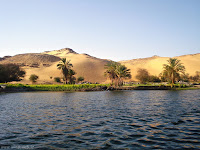The articles of the series Urbem Fecisti are dedicated to the way Rome has shaped the modern world, to its modernity. It's a fact that Roman Empire is still living inside each of us in the western world and not only.
Water Management
Even if my job involved oil refining and petrochemical processes, the main business of the company where I worked for 30 years is water management. Because of that I know that the problems related to water supply and discharge are always challenging, even with today's technologies.
The rise of ancient Rome over the other cities, becoming a super-power and the founder of a new concept of state, a concept that is the one still used, cannot be separated, in my opinion, by the engineering capabilities and by the water managent technologies that Romans developped.
 |
| Nile river |
Rome has been the first city to develop a systematic approach to water management. That allowed the city to reach up to 1.5 million inhabitants without suffering the heavy hygienic problems that plagued other important cities of the ancient world. It's enough to mention that the history of ancient Greece changed when Athens was hit by an epidemic (Plague of Athens), mostly due to poor hygienic conditions, during the Peloponnesian War.
 |
| Cloaca Maxima |
Several other smaller sewers were connected to the Cloaca Maxima so that all the city was served. We have to consider that the sewer system had to be extremely efficient. Apart from the rain, it had to drain the enormous amout of water that was delivered daily to Rome by its eleven aqueducts. We will discuss about that in a future post..
The greatness of that work is testified by the fact that, still today, it is the main sewer of the center of Rome.
Over the centuries and the millennia it has delivered to the Tiber not only dirty water but also objects that were accidentally lost. In the middle of the twentieth century, the municipality of Rome commissioned the drainage of the Tiber bank to an American company. The company was paid with the finds that were recovered from the bottom of the river.
Vincenzo
St. John Villa
San Lorenzo Guest House
Villa Borghese Guest House

Nessun commento:
Posta un commento